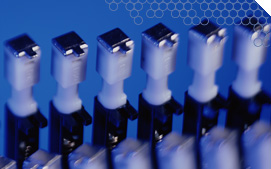Jump To: Single-Layer Generators | Multilayer Generators | Energy Harvesting | Harvesting With Piezo Sensors | Harvesting Technology
Piezoelectric ceramics, when mechanically activated with pressure or vibration, have the capacity to generate electric voltages sufficient to spark across an electrode gap. Piezoelectric ceramics are frequently used in this capacity to ignite a fuel source in lighters, gas stoves and welding equipment. In addition, everything from quartz watches to computer microphones make use of piezo components and the resulting piezoelectric effect to boost their operational performance.
Piezoelectric generators — sometimes referred to as PEGs — are an exciting breakthrough in power generation. They have the potential to help propel the notion of self-powered wireless electronic devices into the realm of reality. Of course, we’re still a long way off from having a piezo vibration generator acting as a major power source. But when it comes to highly stable, reliable power sources, experts believe that piezo generators can change how we help power today’s widely used, efficient electronic devices.

Electrical energy in a rod-shaped single-layer piezo generator is released very quickly, is very high voltage, and very low current. Piezoelectric ignition systems are small and simple, long lasting and require little maintenance.
Multilayer piezo generators consist of a stack of very thin (sub-millimeter-thick) piezoelectric ceramics alternated with electrodes. The electrical energy produced by a multilayer piezo generator is of a much lower voltage than is generated by a single-layer piezo generator. On the other hand, the current produced by a multilayer generator is significantly higher than the current generated by a single-layer piezoelectric generator.
Because they do not create electromagnetic interference, multilayer piezo generators are excellent solid-state batteries for electronic circuits.
Due to advancements in micro-electronic systems many consumer devices have decreased in size. Smaller electronic systems require less power to operate. As a result, solid-state multilayer piezoelectric generators have become a feasible power source for some applications.
Current applications for multilayer piezo generators are energy sources for munitions and wireless sensors, such as sensors that monitor tire pressure in automobiles.
Single-layer and multilayer piezo generators are used in applications where batteries or direct electrical current is not available.
Recently, energy harvesting using piezoelectric energy generation has become the focus of much research. While we are very excited about the prospects of energy harvesting using piezoelectric ceramics, we do have concerns regarding the use of piezoelectric ceramics in large-scale energy harvesting.
Piezoelectric ceramics have limited energy outputs, and therefore are potentially cost-prohibitive to feasibly use in any large-scale energy harvesting application. On the other hand, use of multilayer piezo generators in smaller electronic devices with low power requirements offers a real opportunity for exploration.
With existing piezoelectric materials, it is already possible to harvest electricity and store it for later use. The problem isn’t generating the electricity — it’s generating enough of it. Due to the relatively low energy outputs of PZT materials, the ability to generate and store enough energy using this technology to power a machine, a car or any other large, energy-consuming device is still a long way off.
Much thought has been put into the idea of walkways, stairways and roadways that incorporate piezoelectric materials that harness the electricity generated for storage, but the technology is difficult to scale up to generate adequate energy.
Research continues, however, and improvements in piezoelectric materials, as well as amplification of the energy output, have shown small but positive gains. While they may never be able to generate significant amounts of power, the ability to turn mechanical energy into electrical energy will continue to expand the appeal of piezoelectric materials and piezo sensor uses. Thanks to the reliability and accuracy of products using our piezoelectric materials, they will continue to be an integral part of power generation and conservation across a wide range of industries.
In the automotive and aeronautical industries, every chance to save energy is worth pursuing. The focus isn’t necessarily on finding a revolutionary new fuel source — it’s on finding incremental savings across all systems and sub-systems. This is where piezoelectric materials will continue to play an important role in terms of energy harvesting and use. If a PZT material can generate enough energy to operate a sensor, control or light, for example, it does not need to draw on power from the main power source.
One single piezoelectric transducer might not represent noticeable energy or fuel savings, but as we start to multiply them, we start to see a net gain.
The key to advances in the piezo field rely on materials like our custom piezoelectric ceramics. We can optimize them for your application for increased sensitivity, stability and reliability. It’s an exciting time to be in the piezoelectric ceramics business, as we see a greater push toward intelligent and economical power generation. APC International will continue to research and manufacture advanced piezoelectric products that allow continual improvements in the performance and quality of your transducers, sensors and other equipment.
Whether you’re looking for help designing a single-layer piezo generator prototype or need the production of a complete line of multilayer piezo generators, we can assist you. Our piezo products are already in service in the following industries:
In addition, our manufacturing capabilities are extensive. From designing and machining to custom electroding and testing, we have the capability to fabricate and deliver a wide range of piezoelectric devices in a timely and cost-effective manner.
Basic Overview of Piezoelectric Materials in Energy Harvesting
6 Applications of Piezoelectricity in the Military

Piezoelectric Ceramics: Principles and Applications


To learn more about our comprehensive selection of piezoelectric ceramics and related services, contact us at your earliest convenience. Call (570)726-6961 to speak to one of our representatives.